First things first. If you don’t practice in or own a building in hail alley or a building insured by FM Global, why would you need to read this article?
- Roofs are the first line of defense against severe weather events, including hail.
- The geographic footprint of hailstorms has expanded; more than two-thirds of the United States experiences 1 inch or larger hailstones, increasing insurance claims to between $31 and 49 billion in 20241.
- While FM requirements only apply to FM insured buildings, the potential for damage applies to all buildings. It is not uncommon for owners and designers that do not insure buildings through FM to elect to follow FMs guidelines to protect their investments and mitigate their design risk.
And if you do practice in or own a building in hail alley, how will you know which Very Severe Hail (VSH) rated assembly to select out of the 16,500+ approved assemblies?

Photo courtesy of GAF
What in the Hail Does Very Severe Hail Mean?
When Very Severe Hail (VSH) requirements were introduced to the roofing industry, it was as if all hail was about to break loose! The issue was obvious. Buildings were being pelted with larger and more frequent hail storms. In 2022, insured losses from hailstorms topped $20 billion.2 According to the National Center for Atmospheric Research, hail events account for 70 percent of the average annual property losses from severe convective storms in the United States.
How in the hail was the industry to respond to VSH? Before unpacking the impact of hail, and how the roofing industry has and is responding to the need to enhance the protection of buildings from the damaging effects of hail, let’s start with understanding it.
Hail is solid ice that forms when raindrops are carried upward by thunderstorm updrafts into the extremely cold atmosphere and freeze. Hailstones collide with liquid water that freezes onto the surface of the hailstone. Hail falls when the thunderstorm's updraft can no longer support the weight of the hailstone and
According to National Oceanic and Atmospheric Administration’s National Severe Storms Laboratory (NOAA NSSL), VSH (2 inches in diameter or larger) forms in supercell thunderstorms as they have sustained updrafts that support large hail formation by repeatedly lifting the hailstones into the very cold air at the top of the thunderstorm cloud where they can accumulate more layers of ice.
NOAA produced a report on “The Frequency of Large Hail Over the Contiguous United States” back in 2003.3 This report notes that the annual average number of reported severe hail events jumped from about 1,100 in the late 1970s to almost 2,500 in the early 1980s. The area roughly correlated to “tornado alley” reported an increase of 600 severe hail reports per decade with over 5000 annual events in 2024.
During the winter, severe hailstorms are generally restricted to the Southeast. Most activity occurs in a band from east Texas to north Alabama. Meteorologically, this is a reflection of the relatively cool temperatures across the continent, the general lack of moisture in the air anywhere but along the coast of the Gulf of Mexico, and the low sun angle that limits the area of insolation sufficient for thunderstorm development. In April, the sun angle and length of daytime heating increases and moisture returns northward due to the strengthening of the Bermuda High. This, in concert with northward migration of the jet stream, shifts the maximum hail area to Oklahoma and the Red River Valley.
Continued northward progression shifts the July maximum to the Plains from eastern Colorado to northern Minnesota. There is also a weak summer maximum in smaller hail sizes over the desert southwest, indicating reports from hailstorms occurring with the North American monsoon. The northwestern states also have a small signal during this period, as extreme heating along the sloping terrain during the summer months helps to produce instability over this region leading to some severe hail producing storms.
A small July area of enhanced hail activity is also located in Central Florida in the area where the Atlantic and Gulf of Mexico sea breezes often interact. Over the rest of the Southeast, except for along the Appalachians, hail activity during the summer is suppressed by the warm troposphere. In the autumn, the severe hail activity pattern is quite similar to the spring pattern. However, the occurrence rate is greatly diminished.
NOAA reports a significant increase in hail events over the past decade, averaging over 5,300 events annually. Hail-related insured losses between 2000 and 2019 averaged between $8 billion to $14 billion a year, according to Aon.4 According to Versik, 49% of the aggregated average annual loss was due to hail in 2024, nearly equal to tornado and straight-line winds combined.5
Despite this large number of events, collectively they have fallen below the 10-year average. While the occurrence of hailstorms has increased year over year, the occurrence of hailstones larger than 1.5" has dropped over the last few years. As a result, hail-related claims have dropped year over year since 2021 since the larger claims are caused by larger hail.

Source: NOAA, Storm Events Database
Figure 1: Number of hail events over the past decade.
The Insurance Information Institute reports that Texas, Missouri, Kansas, Oklahoma, and Nebraska have had the greatest number of hail events. The top five states have had more than 2500 hail events in a single year, though the specific top five changes slightly each year.
These events represented a wider geographic footprint and nearly 10 percent more U.S. properties were affected by hail since 2020. This was due, in part, to a growing number of hail events in the eastern United States, which is more densely populated than the traditional “hail alley” states.
With an estimated 1,591,074 properties, representing 17 percent of the state’s total properties, Texas has nearly 1 million more properties affected by hail than the next-highest state, Indiana. The total number of Texas properties affected by hail grew by 80,000 from 2020 to 2021. This accounted for nearly one quarter of all properties affected by hail events in 2021.
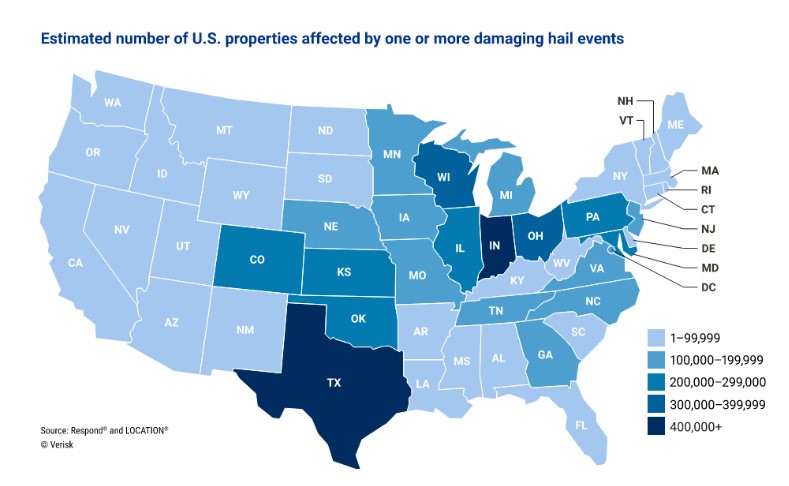
Source: NOAA, graphed by Verisk
Figure 3: The estimated number of properties affected by one or more damaging hail events.
Coinciding with the increase in properties affected by a damaging hail event in 2021, there was also an increase in claims, which rose to $16.5 billion from $14.2 billion in 2020. Texas continued to lead with $5.1 billion in claims due to hail damage—nearly a $2 billion increase from $3.3 billion the previous year. Indiana, the second most-impacted state, had nearly an order of magnitude fewer claims than Texas, with $527,000 in claims from the 17 percent of its housing stock affected by hail.
In 2021, more than 6.8 million properties in the United States were affected by one or more damaging hail events. Almost one quarter of the U.S. properties affected by hail were in Texas; over 1.5 million properties. Below are some images from damage resulting from a VSH event.
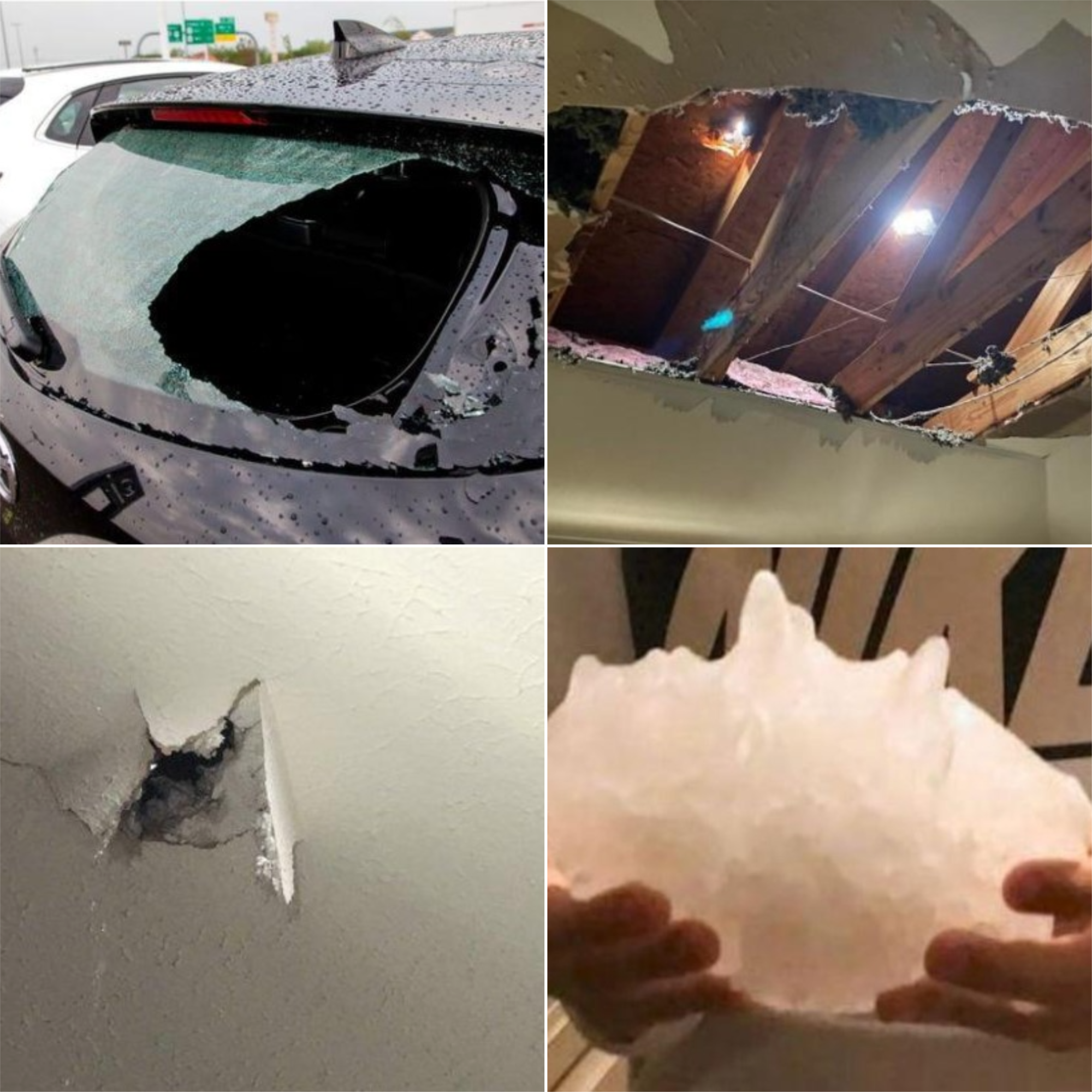
Images courtesy of USA Today, Reddit, Twitter, and the National Weather Service (top left to bottom right).
Figure 4: April 28th, 2021 – Texas/Oklahoma hail event which produced the largest hailstone measured in Texas at 6.4 inches, the size of a honeydew melon.
According to data from Factory Mutual Insurance Company (FM Global), a leader in establishing best practices to protect buildings, the review of client losses between 2016-2020, showed that the average wind/hail losses averaged $931,000 per event. That’s a significant impact on a business, and it doesn’t account for the other longer-term effects that a disruptive loss could have; impacts on reputation, market share, and investor confidence, for example. This underscores why risk mitigation is so important given such impacts are unlikely to be covered by insurance policies.
VSH Designation
FM Global estimates their clients lose about $130M6 each year on average from hail events in the United States. Instances of severe hail storms are now widespread across the United States. About two-thirds of the U.S. experiences 1-inch or larger hailstones. Given the increasing volume of severe hail events and the resulting property loss, damage, and financial impacts, FM Global added to the requirements in the FM Loss Prevention Data Sheet (LPDS) 1-34 Hail Damage in 2018.
FM’s LPDS 1-34 was updated in 2024 and identified the VSH region as encompassing Oklahoma, Kansas, Nebraska, South Dakota, most of Texas, and parts of Montana, North Dakota, Minnesota, Iowa, Missouri, Arkansas, Wyoming, Colorado, and New Mexico. Note that the top 5 states listed above with the highest number of hail events are the first 5 states listed in the VSH region.

Figure 5: FM’s LPDS 1-34 map outlining the different hail categories—moderate, severe and very severe. The Very Severe region is most commonly referred to as “Hail alley.”
FM Approvals is a third-party testing and certification laboratory with a focus on testing products for property loss prevention using rigorous standards. FM Global, through the loss prevention data sheets, requires the use of FM Approved roof systems.
FM Approvals designed the hail tests for all regions with a 15 year mean recurrence interval. The Moderate Hail zone is based on an equivalent hail size of less than 1.75 inches; the Severe Hail zone is based on 1.75- to 2-inch size hail; and the Very Severe Hail zone is based on greater than or equal to 2-inch diameter sized hail.

Figure 6: Description of FM Approval hail regions.
Roof systems seeking the VSH designation are tested on accelerated aged roof membranes that are subject to a more severe hail impact (higher impact energy). The test protocol evaluates damage to the roof membrane as well as the coverboard located beneath the membrane. VSH testing of roof systems is considerably more difficult to pass than the previous Severe Hail rating.
The VSH test follows ANSI FM 4470, which has requirements for single-ply, polymer-modified bitumen sheet, built-up roof (BUR) and liquid applied roof assemblies for use in Class 1 and noncombustible roof deck Construction, and includes launching a 2-inch diameter ice ball from a hail gun, propelled at 152 to 160 ft/s, resulting in an impact energy of 53 to 58 ft-lb tested on the roof system with three different conditioned roof membranes:
- An unaged sample
- A sample after 1,000 hours of UV weathering; and
- A sample after 1,000 hours of UV weathering and 1,000 hours of heat aging
The roof membrane and field seam cannot show any signs of cracking or splitting under 10X magnification and the coverboard substrate cannot crack in order to pass this test.
In contrast, the Severe Hail rating has an impact energy of 14 ft-lbs and is only tested on unaged and UV weathered roof membrane samples, not heat aged membrane. The VSH test is the most stringent of tests designed to identify systems that can better protect buildings and ultimately reduce claims.
Research on the Impacts of Hail
FM 4470 calls for a pass/fail rating based on whether or not the roof assembly has been visually punctured or dented by the ice ball impact.7 One study that evaluated the impact resistance of roof membranes at various thicknesses and attachment methods found that as long as impact was not above a fastener, the membrane was not punctured, even with a 45 mil membrane.
Note that this study was completed on unaged material, with all testing completed at room temperature, which does not replicate conditions for an aged roof exposed to a hail event, nor does it replicate the testing requirements for VSH assemblies. However, the findings summarize a few important concepts in regards to protection against hail events.
The impact resistance of the roof is really a system discussion, above and beyond just the membrane. All of the elements of the roof need to be considered in tandem to truly understand how they can work together to protect the building from the damaging impacts of hail.
The study highlighted this concept by evaluating the impact effects of hail on varied membrane thicknesses, as well as coverboards, and attachment methods. Each of these elements will influence the system's performance. This study showed the benefits of using a thicker roof membrane, especially a fleeceback single-ply membrane. It also revealed that coverboards and insulation can also be damaged by hail. So focusing solely on the damage observed to the roof membrane doesn’t tell the full story, especially with larger hailstones. This is why the VSH acceptance criteria includes the entire assembly, not just the roof membrane.
Another study aged the membrane to the 30-year heat-aged equivalence point and tested a standard Thermoplastic Polyolefin (TPO) membrane and one specifically designed for high-temperature resistance and long-life (long-life TPO) in demanding applications. Fleeceback TPO membrane is specifically designed to enhance impact resistance from hail, even as it ages and demonstrates the best performance. The extra cushion provided by the fleece renders the membrane more forgiving to impact.
When VSH assemblies first came to market, plywood and OSB were used as “coverboards” to achieve that rating, which are very labor intensive to install. Manufacturers of coverboards and roof membranes have teamed up to provide enhanced solutions to the VSH conundrum.
New glass mat roof boards (coverboards) on the market specifically designated for VSH have increased the number of systems available, enhanced performance, and expanded designers capabilities by passing the VSH testing with simultaneously fastened or “gang fastened’ systems, meaning the roof insulation and coverboards are secured to the roof deck with fasteners concurrently extending through all layers (as shown in Figure 7).
There are now solutions for projects that may benefit from mechanical attachment, including weather limitations, existing deck constraints, high uplift pressures or designers preference. Additionally, mechanically attached systems are often quicker, easier and more cost effective to install than adhered systems, which could offset the cost of the VSH assembly.


Figure 7: VSH systems. Left is simultaneously fastened 60 mil Fleeceback TPO over glass mat VSH roof board and Polyiso Insulation. Right is 60 mil Fleeceback TPO over glass mat VSH roof board adhered in low rise foam ribbons to mechanically attached Polyiso Insulation.
The early VSH assemblies were not successful with mechanically attached coverboards or single ply membranes. The impact of the ice ball would result in a failure. However, with the new glass mat roof boards, mechanical attachment of the coverboards and insulation (simultaneously fastened systems) is possible as shown in Figure 7.
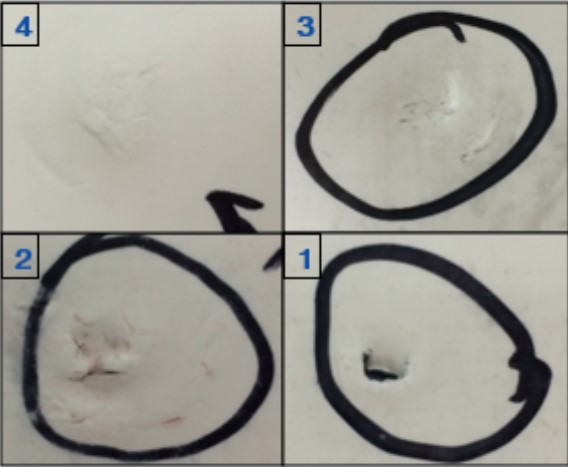
Figure 8

Figure 8: This data combines the previously referenced study with FM VSH testing of assemblies with the glass mat roof boards. A #5.0 rating indicates no damage, while a #1.0 rating indicates a full puncture of the roof membrane.
The RICOWI Hailstorm Investigation Report noted that the use of coverboards with relatively high compressive strength improved performance of low-slope roof membranes against hail impacts, specifically noting:
About one-third of the inspected low-slope roof covers were supported by a relatively high compressive strength substrate. Over 43 percent of the membranes installed over low compressive substrates had significant damage and only 25 percent of the roof covers installed over high compressive strength substrates had damage.
Modified bitumen roof covers installed directly over low compressive strength substrates have been found to be the system most prone to damage causing leaks in all three RICOWI hail investigations. Single-ply membranes generally had good performance with only a small number of roofs sustaining damage with less than 1.5-inch hail, and several performing adequately with 2-inch or larger hail.8
First things first. If you don’t practice in or own a building in hail alley or a building insured by FM Global, why would you need to read this article?
- Roofs are the first line of defense against severe weather events, including hail.
- The geographic footprint of hailstorms has expanded; more than two-thirds of the United States experiences 1 inch or larger hailstones, increasing insurance claims to between $31 and 49 billion in 20241.
- While FM requirements only apply to FM insured buildings, the potential for damage applies to all buildings. It is not uncommon for owners and designers that do not insure buildings through FM to elect to follow FMs guidelines to protect their investments and mitigate their design risk.
And if you do practice in or own a building in hail alley, how will you know which Very Severe Hail (VSH) rated assembly to select out of the 16,500+ approved assemblies?

Photo courtesy of GAF
What in the Hail Does Very Severe Hail Mean?
When Very Severe Hail (VSH) requirements were introduced to the roofing industry, it was as if all hail was about to break loose! The issue was obvious. Buildings were being pelted with larger and more frequent hail storms. In 2022, insured losses from hailstorms topped $20 billion.2 According to the National Center for Atmospheric Research, hail events account for 70 percent of the average annual property losses from severe convective storms in the United States.
How in the hail was the industry to respond to VSH? Before unpacking the impact of hail, and how the roofing industry has and is responding to the need to enhance the protection of buildings from the damaging effects of hail, let’s start with understanding it.
Hail is solid ice that forms when raindrops are carried upward by thunderstorm updrafts into the extremely cold atmosphere and freeze. Hailstones collide with liquid water that freezes onto the surface of the hailstone. Hail falls when the thunderstorm's updraft can no longer support the weight of the hailstone and
According to National Oceanic and Atmospheric Administration’s National Severe Storms Laboratory (NOAA NSSL), VSH (2 inches in diameter or larger) forms in supercell thunderstorms as they have sustained updrafts that support large hail formation by repeatedly lifting the hailstones into the very cold air at the top of the thunderstorm cloud where they can accumulate more layers of ice.
NOAA produced a report on “The Frequency of Large Hail Over the Contiguous United States” back in 2003.3 This report notes that the annual average number of reported severe hail events jumped from about 1,100 in the late 1970s to almost 2,500 in the early 1980s. The area roughly correlated to “tornado alley” reported an increase of 600 severe hail reports per decade with over 5000 annual events in 2024.
During the winter, severe hailstorms are generally restricted to the Southeast. Most activity occurs in a band from east Texas to north Alabama. Meteorologically, this is a reflection of the relatively cool temperatures across the continent, the general lack of moisture in the air anywhere but along the coast of the Gulf of Mexico, and the low sun angle that limits the area of insolation sufficient for thunderstorm development. In April, the sun angle and length of daytime heating increases and moisture returns northward due to the strengthening of the Bermuda High. This, in concert with northward migration of the jet stream, shifts the maximum hail area to Oklahoma and the Red River Valley.
Continued northward progression shifts the July maximum to the Plains from eastern Colorado to northern Minnesota. There is also a weak summer maximum in smaller hail sizes over the desert southwest, indicating reports from hailstorms occurring with the North American monsoon. The northwestern states also have a small signal during this period, as extreme heating along the sloping terrain during the summer months helps to produce instability over this region leading to some severe hail producing storms.
A small July area of enhanced hail activity is also located in Central Florida in the area where the Atlantic and Gulf of Mexico sea breezes often interact. Over the rest of the Southeast, except for along the Appalachians, hail activity during the summer is suppressed by the warm troposphere. In the autumn, the severe hail activity pattern is quite similar to the spring pattern. However, the occurrence rate is greatly diminished.
NOAA reports a significant increase in hail events over the past decade, averaging over 5,300 events annually. Hail-related insured losses between 2000 and 2019 averaged between $8 billion to $14 billion a year, according to Aon.4 According to Versik, 49% of the aggregated average annual loss was due to hail in 2024, nearly equal to tornado and straight-line winds combined.5
Despite this large number of events, collectively they have fallen below the 10-year average. While the occurrence of hailstorms has increased year over year, the occurrence of hailstones larger than 1.5" has dropped over the last few years. As a result, hail-related claims have dropped year over year since 2021 since the larger claims are caused by larger hail.

Source: NOAA, Storm Events Database
Figure 1: Number of hail events over the past decade.
The Insurance Information Institute reports that Texas, Missouri, Kansas, Oklahoma, and Nebraska have had the greatest number of hail events. The top five states have had more than 2500 hail events in a single year, though the specific top five changes slightly each year.
These events represented a wider geographic footprint and nearly 10 percent more U.S. properties were affected by hail since 2020. This was due, in part, to a growing number of hail events in the eastern United States, which is more densely populated than the traditional “hail alley” states.
With an estimated 1,591,074 properties, representing 17 percent of the state’s total properties, Texas has nearly 1 million more properties affected by hail than the next-highest state, Indiana. The total number of Texas properties affected by hail grew by 80,000 from 2020 to 2021. This accounted for nearly one quarter of all properties affected by hail events in 2021.

Source: NOAA, graphed by Verisk
Figure 3: The estimated number of properties affected by one or more damaging hail events.
Coinciding with the increase in properties affected by a damaging hail event in 2021, there was also an increase in claims, which rose to $16.5 billion from $14.2 billion in 2020. Texas continued to lead with $5.1 billion in claims due to hail damage—nearly a $2 billion increase from $3.3 billion the previous year. Indiana, the second most-impacted state, had nearly an order of magnitude fewer claims than Texas, with $527,000 in claims from the 17 percent of its housing stock affected by hail.
In 2021, more than 6.8 million properties in the United States were affected by one or more damaging hail events. Almost one quarter of the U.S. properties affected by hail were in Texas; over 1.5 million properties. Below are some images from damage resulting from a VSH event.

Images courtesy of USA Today, Reddit, Twitter, and the National Weather Service (top left to bottom right).
Figure 4: April 28th, 2021 – Texas/Oklahoma hail event which produced the largest hailstone measured in Texas at 6.4 inches, the size of a honeydew melon.
According to data from Factory Mutual Insurance Company (FM Global), a leader in establishing best practices to protect buildings, the review of client losses between 2016-2020, showed that the average wind/hail losses averaged $931,000 per event. That’s a significant impact on a business, and it doesn’t account for the other longer-term effects that a disruptive loss could have; impacts on reputation, market share, and investor confidence, for example. This underscores why risk mitigation is so important given such impacts are unlikely to be covered by insurance policies.
VSH Designation
FM Global estimates their clients lose about $130M6 each year on average from hail events in the United States. Instances of severe hail storms are now widespread across the United States. About two-thirds of the U.S. experiences 1-inch or larger hailstones. Given the increasing volume of severe hail events and the resulting property loss, damage, and financial impacts, FM Global added to the requirements in the FM Loss Prevention Data Sheet (LPDS) 1-34 Hail Damage in 2018.
FM’s LPDS 1-34 was updated in 2024 and identified the VSH region as encompassing Oklahoma, Kansas, Nebraska, South Dakota, most of Texas, and parts of Montana, North Dakota, Minnesota, Iowa, Missouri, Arkansas, Wyoming, Colorado, and New Mexico. Note that the top 5 states listed above with the highest number of hail events are the first 5 states listed in the VSH region.

Figure 5: FM’s LPDS 1-34 map outlining the different hail categories—moderate, severe and very severe. The Very Severe region is most commonly referred to as “Hail alley.”
FM Approvals is a third-party testing and certification laboratory with a focus on testing products for property loss prevention using rigorous standards. FM Global, through the loss prevention data sheets, requires the use of FM Approved roof systems.
FM Approvals designed the hail tests for all regions with a 15 year mean recurrence interval. The Moderate Hail zone is based on an equivalent hail size of less than 1.75 inches; the Severe Hail zone is based on 1.75- to 2-inch size hail; and the Very Severe Hail zone is based on greater than or equal to 2-inch diameter sized hail.

Figure 6: Description of FM Approval hail regions.
Roof systems seeking the VSH designation are tested on accelerated aged roof membranes that are subject to a more severe hail impact (higher impact energy). The test protocol evaluates damage to the roof membrane as well as the coverboard located beneath the membrane. VSH testing of roof systems is considerably more difficult to pass than the previous Severe Hail rating.
The VSH test follows ANSI FM 4470, which has requirements for single-ply, polymer-modified bitumen sheet, built-up roof (BUR) and liquid applied roof assemblies for use in Class 1 and noncombustible roof deck Construction, and includes launching a 2-inch diameter ice ball from a hail gun, propelled at 152 to 160 ft/s, resulting in an impact energy of 53 to 58 ft-lb tested on the roof system with three different conditioned roof membranes:
- An unaged sample
- A sample after 1,000 hours of UV weathering; and
- A sample after 1,000 hours of UV weathering and 1,000 hours of heat aging
The roof membrane and field seam cannot show any signs of cracking or splitting under 10X magnification and the coverboard substrate cannot crack in order to pass this test.
In contrast, the Severe Hail rating has an impact energy of 14 ft-lbs and is only tested on unaged and UV weathered roof membrane samples, not heat aged membrane. The VSH test is the most stringent of tests designed to identify systems that can better protect buildings and ultimately reduce claims.
Research on the Impacts of Hail
FM 4470 calls for a pass/fail rating based on whether or not the roof assembly has been visually punctured or dented by the ice ball impact.7 One study that evaluated the impact resistance of roof membranes at various thicknesses and attachment methods found that as long as impact was not above a fastener, the membrane was not punctured, even with a 45 mil membrane.
Note that this study was completed on unaged material, with all testing completed at room temperature, which does not replicate conditions for an aged roof exposed to a hail event, nor does it replicate the testing requirements for VSH assemblies. However, the findings summarize a few important concepts in regards to protection against hail events.
The impact resistance of the roof is really a system discussion, above and beyond just the membrane. All of the elements of the roof need to be considered in tandem to truly understand how they can work together to protect the building from the damaging impacts of hail.
The study highlighted this concept by evaluating the impact effects of hail on varied membrane thicknesses, as well as coverboards, and attachment methods. Each of these elements will influence the system's performance. This study showed the benefits of using a thicker roof membrane, especially a fleeceback single-ply membrane. It also revealed that coverboards and insulation can also be damaged by hail. So focusing solely on the damage observed to the roof membrane doesn’t tell the full story, especially with larger hailstones. This is why the VSH acceptance criteria includes the entire assembly, not just the roof membrane.
Another study aged the membrane to the 30-year heat-aged equivalence point and tested a standard Thermoplastic Polyolefin (TPO) membrane and one specifically designed for high-temperature resistance and long-life (long-life TPO) in demanding applications. Fleeceback TPO membrane is specifically designed to enhance impact resistance from hail, even as it ages and demonstrates the best performance. The extra cushion provided by the fleece renders the membrane more forgiving to impact.
When VSH assemblies first came to market, plywood and OSB were used as “coverboards” to achieve that rating, which are very labor intensive to install. Manufacturers of coverboards and roof membranes have teamed up to provide enhanced solutions to the VSH conundrum.
New glass mat roof boards (coverboards) on the market specifically designated for VSH have increased the number of systems available, enhanced performance, and expanded designers capabilities by passing the VSH testing with simultaneously fastened or “gang fastened’ systems, meaning the roof insulation and coverboards are secured to the roof deck with fasteners concurrently extending through all layers (as shown in Figure 7).
There are now solutions for projects that may benefit from mechanical attachment, including weather limitations, existing deck constraints, high uplift pressures or designers preference. Additionally, mechanically attached systems are often quicker, easier and more cost effective to install than adhered systems, which could offset the cost of the VSH assembly.


Figure 7: VSH systems. Left is simultaneously fastened 60 mil Fleeceback TPO over glass mat VSH roof board and Polyiso Insulation. Right is 60 mil Fleeceback TPO over glass mat VSH roof board adhered in low rise foam ribbons to mechanically attached Polyiso Insulation.
The early VSH assemblies were not successful with mechanically attached coverboards or single ply membranes. The impact of the ice ball would result in a failure. However, with the new glass mat roof boards, mechanical attachment of the coverboards and insulation (simultaneously fastened systems) is possible as shown in Figure 7.

Figure 8

Figure 8: This data combines the previously referenced study with FM VSH testing of assemblies with the glass mat roof boards. A #5.0 rating indicates no damage, while a #1.0 rating indicates a full puncture of the roof membrane.
The RICOWI Hailstorm Investigation Report noted that the use of coverboards with relatively high compressive strength improved performance of low-slope roof membranes against hail impacts, specifically noting:
About one-third of the inspected low-slope roof covers were supported by a relatively high compressive strength substrate. Over 43 percent of the membranes installed over low compressive substrates had significant damage and only 25 percent of the roof covers installed over high compressive strength substrates had damage.
Modified bitumen roof covers installed directly over low compressive strength substrates have been found to be the system most prone to damage causing leaks in all three RICOWI hail investigations. Single-ply membranes generally had good performance with only a small number of roofs sustaining damage with less than 1.5-inch hail, and several performing adequately with 2-inch or larger hail.8
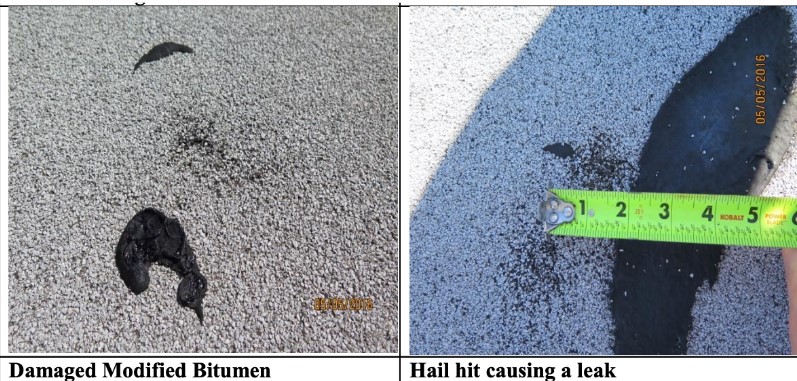
Figure 9: Modified Bitumen system over low compressive strength coverboard. RICOWI Hailstorm Investigation Report North Texas Hailstorm 2016.
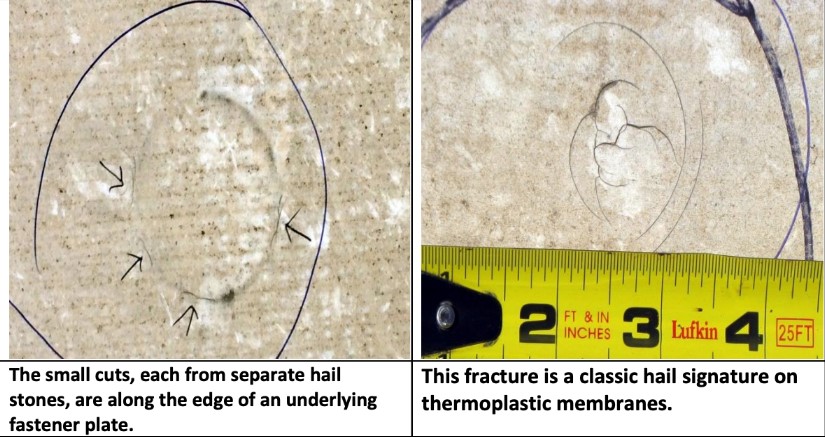
Figure 10: PVC roof membrane over high compressive strength coverboard. RICOWI Hailstorm Investigation Report North Texas Hailstorm 2016.
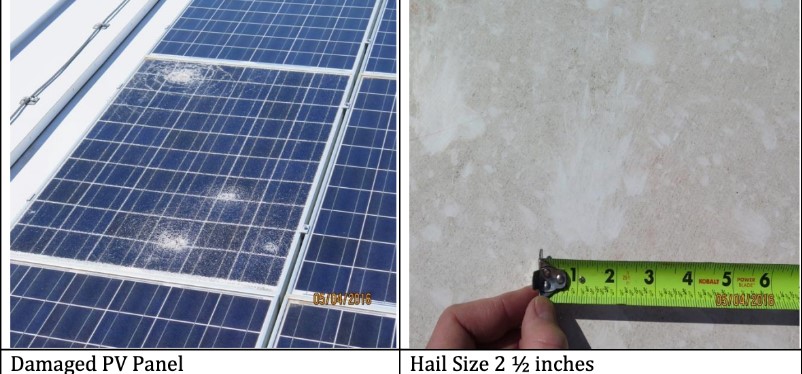
Figure 11: Single-ply roof membrane over high compressive strength coverboard. RICOWI Hailstorm Investigation Report North Texas Hailstorm 2016.
While RICOWI’s investigation revealed lower performance of modified bitumen assemblies with low compressive strength coverboards, this is not a surprise. Many older asphaltic roof systems utilized fiberboard and perlite coverboards which inherently have a low compressive strength. These roofs were installed prior to FM’s VSH requirements. There are asphaltic roof assemblies that do perform well under VSH events, as shown in Figure 12 below.
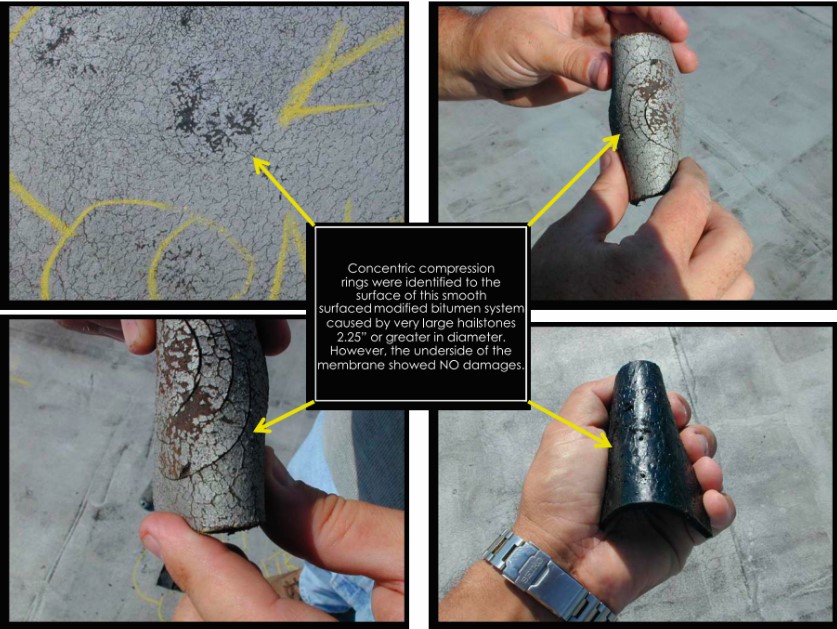
Figure 12: Asphaltic roof assemblies over high compressive strength coverboards can perform well under VSH events. Image courtesy of Grayco Consulting.
Designing Roofs in VSH Regions
Testing and observing post hail events has provided architects, specifiers, and roof consultants with guidance on how to design roofs to withstand the impacts of VSH. Membrane selection is critical for VSH prone regions. Thicker roof membranes, as well as higher performance grades that will remain pliable under heat and UV exposure over years in service will outperform standard grade materials. Fleeceback membranes also provide an added cushion layer that buffers the negative effects of hail events. High compressive strength coverboards were shown to be an effective means to enhance the performance of the roof system when exposed to hail events.
Using a coverboard will enhance the roof’s long term performance by fortifying the membrane when hail strikes as well as providing a firm and smooth surface to help resist damage from typical foot traffic. It will also help the roof insulation below withstand damage from hail. Coverboard selection is a critical component of the roof system design. Coverboards for VSH systems were originally limited to plywood or oriented strand board (OSB), often 7/16 to 19/32 inches in thickness.
The use of plywood and OSB is very labor intensive to install as compared to traditional gypsum coverboards, increasing the cost of the installation. Conventional gypsum coverboards struggled to provide the necessary protection for VSH assemblies, crushing under the impact of a 2-inch ice ball. Recently, coverboard manufacturers have developed glass mat roof boards which are a reinforced gypsum core with a heavy-duty coated glass mat facer. Not only do these boards provide protection against 2-inch hail and are an important part of VSH assemblies, they are also a FM Class 1 and UL Class A thermal barrier for fire rated assemblies.
These boards are 5/8 inches thick and are 92-96 pounds per 4-foot by 8-foot board; about 30 percent heavier compared to plywood yet easier to install as they can be scored and cut like a traditional gypsum board. There are VSH rated assemblies that leverage the strength of the coated glass mat roof boards in combination with adhered fleeceback TPO membranes, to provide a simultaneously fastened system, meaning the coverboard and insulation can be mechanically fastened, and still achieve a VSH assembly rating.

Figure 13: A sample of available VSH assemblies.
Specifying a hail warranty or guarantee is necessary for owners that anticipate hail coverage, which is not implicit with VSH rated assemblies. Standard roofing warranties and guarantees do not typically provide coverage against hail or other impact. Hail or puncture resistance coverage may be available, often for purchase, for eligible systems. Most roof manufacturers offer 2-inch hail coverage, while 3-inch hail coverage may require a technical variance and can be largely dependent on the designed roof system, the qualifications of the installing roof contractor, and project specific details.
VSH Rated Assemblies
The most critical part of a VSH design is selecting an approved assembly, meaning it’s been tested for VSH performance and approved by FM Approvals. In 2018 when FM Global first implemented the VSH rating, there were virtually no systems to be had; 44 to be exact. Manufacturers have responded to the VSH designation with more robust assemblies to minimize damage. In 2019, there were approximately 1,700 VSH rated assemblies available. In 2021, there were just over 10,000 VSH rated assemblies.9 In 2025, this number has grown to nearly 35,000 VSH rated assemblies!
Research and field experience reviewing storm damage has shown the use of thicker roof membranes, especially fleeceback membranes, provide greater impact resistance. Burying fasteners within the roof system and the use of adhesives for subsequent layers has also been a go-to strategy when enhancing the impact resistance of the roof. Innovations in coverboards have resulted in even more options than were available in the past.
New glass mat roof boards on the market specifically designated for VSH have increased the number of assemblies available. These new coverboards have significantly increased the number of single-ply assemblies that comply with the VSH requirements—nearly 40 percent of the available rated assemblies are single-ply membranes. And of these newly available assemblies, several allow for simultaneously fastened or “gang fastened’ systems, providing project teams with more design options to accommodate for wind uplift requirements, installation options for different climate conditions, as well as design preferences.
There are a few methods to identify and specify VSH approved assemblies. FM Global has guidance for designers in the LPDS 1-34 as well as RoofNav, which is a free web-based tool developed by FM Approvals to provide access to the most up-to-date FM Approved roofing products and assemblies.
FM LPDS 1-34 includes commentary for designers. Table 2.3-1 provides two paths to comply with the VSH requirements—selection of a Very Severe Hail rated assembly, or a system with poured concrete or concrete pavers over the roof membrane. The commentary in section 3.1 states that concrete and concrete pavers can protect roof covers from hail larger than 2.5 inches.
Section 3.1 provides guidance of roof selection and states, “When using Table 2.3-1, selecting roofs with higher hail ratings, thicker membranes, and/or harder coverboards (such as gypsum or wood) can reduce roof and interior water damage from many hail storms.”
Section 2.2.1.1 directs users to RoofNav to find properly rated roof assemblies. As of June 2025, RoofNav offers nearly 35,000 VSH rated assemblies. Of the 22,000+ assemblies designated for new roof systems, nearly 40 percent are single-ply systems. Roof recover assemblies with VSH ratings are about 30 percent single-ply systems. Reroof assemblies are currently about 30 percent single-ply systems. The new coverboards on the market and ability to simultaneously fasten the systems will lead to an increase of available reroof assemblies with a VSH rating.
While LPDS 1-34 and RoofNav provide guidance and a user-friendly assembly selection tool, roof manufacturers are often a great resource to answer any questions about approved assemblies and the nuances found in the approval listings. Manufacturers are often able to assist designers in converting their specification for a VSH rated roof assembly.
While FM requirements only apply to FM insured buildings, the potential damage to the roof in these locations applies to all buildings. It is not uncommon for owners and designers that do not insure buildings through FM to elect to follow FMs guidelines to protect their investments and mitigate their design risk.
Roofs: The First Line of Defense Against Hail
Roofs are the first line of defense against severe weather events. With severe weather expanding beyond the traditional hail alley states—and larger hailstones developing more frequently—understanding material selection, aged condition, maintenance, and replacement options are key components to managing this risk. Choosing the right roof system could be the difference between weathering the storm or losing revenue from shutting down business.
Hail can severely damage a roof as low-slope roofs accept the full assault of the hail event. It’s important to quickly repair the damage to mitigate any resulting leaks and mitigate the risk of damage from subsequent events. Damage can include dents, cracking, crazing (circular microfractures), mineral loss on asphaltic sheets (primary UV protector), and exposure of roof membrane reinforcement.
Making the case for investing in a VSH roof system for owners can take several paths. For owners who have FM Insured buildings, they have a choice to make between increased premiums for a severe hail rated assembly or reduced premiums for a more costly VSH rated assembly. There should be a savings with installing VSH rated assemblies; the question is how much and is the owner willing and able to finance the upfront investment to upgrade.
There is more to consider than just the upfront costs of upgrading to a VSH assembly. Making the investment in a more robust roof system means less chances of roof damage that can lead to water intrusion that can cause disruption, damaged goods, mold growth, and/or loss of business. It can also lead to premature roof replacement that may not be covered by insurance.
There is more to managing risk than just the upfront investment in the roof assembly. Design that provides a rated assembly and quality materials are essential. Good workmanship during the installation is a critical component to a successful roof installation. Specifying third party inspections by a Registered Roof Observer (RRO) and quality assurance protocol during construction can help identify and resolve any issues before there is a problem. The owner also plays a part in the long term performance of the roof.
Maintenance is essential to keep drains cleared and debris off the roof that could puncture or otherwise damage the membrane. Routine inspections should be performed to quickly identify any damage caused from maintenance, service contractors or storm damage, as well as signs of wear and tear and overall aging. A Registered Roof Consultant (RRC) can provide an independent assessment of the roof’s condition and develop repair recommendations as needed.
There are many buildings that are not FM Insured and still the owners have decided upon or agree to follow the requirements for VSH rated assemblies. Taking the precautionary measures available to protect their building can provide owners and designers alike with a sense of confidence in the longevity of their investment by mitigating their risk and protecting the occupants and contents.
Utilizing a fleeceback membrane over a standard smooth-back single ply membrane enhances the performance as it relates to impact. The fleeceback TPO membrane is specifically designed for durability in demanding situations in terms of impact and puncture resistance, even as it ages. Designers and owners alike often rely on the added cushion and related protection to justify the cost premium for many projects in VSH regions.
Fleeceback membranes can also be faster to install, depending on the time of installation. A fleeceback membrane adhered in low rise foam can be faster to install than adhered smooth-back membranes which can require adhesive application to the coverboard as well as the backside of the membrane, plus time for the adhesive to become tacky and flash off. A faster installation often results in a lower installation cost, which can increase the number of design options that meet the project budget.
While a fleeceback membrane is at a premium compared to the standard smooth-back counterpart, the enhanced performance with VSH as well as the extended warranty or guarantee coverage lends itself to be a worthwhile design consideration.
Designers previously relied on adhered coverboards and membranes for the VSH rating. Adhered systems are often more costly from a material and installation standpoint. Some designers prefer mechanically attaching roof systems, especially in higher wind uplift regions.
Depending on the time of installation, project size and location, and crew size, there are potential labor savings with a mechanically attached system, which is one of the reasons the simultaneously fastened VSH assemblies have come to market in the past year, providing designers and contractors alike with more options which could result in cost savings to the owner.
Utilizing a cushion of the fleeceback TPO membrane over a simultaneously fastened glass mat roof board (coverboard) provides the longest available warranty or guarantee coverage for VSH assemblies. The extended warranty along with the reduced labor cost can support the cost premium of the fleeceback material.
A roof recover is typically a more cost effective solution than a reroof, as there is a significant labor savings without removing the existing system and there is a savings on insulation materials. It is important to select an assembly that is approved for recover scenarios. The majority of the approved VSH assemblies are for new roofs. There is a much smaller percentage available for roof recovers. However, the approved assemblies for roof recovers is expected to grow over the next year as manufacturers continue to test assemblies with the new coverboards.
Pricing of the VSH coverboards can vary greatly depending on market conditions. Carefully consider any substitution requests for coverboard materials. While the intent may be to save money, FM still requires an approved VSH assembly and coverboards by different manufacturers are not interchangeable.
Hail to VSH Designations—What You Need to Know
In a nutshell, here’s what you need to know about VSH.
Roofs are the first line of defense against severe weather events, including hail. Insured losses from hail events have exceeded $10 billion in the United States annually since 2007. The geographic footprint of hailstorms has expanded and about two-thirds of the United States experiences 1-inch or larger hailstones. Nearly 10 percent more U.S. properties, more than 6.8 million, were affected by hail in 2021 than in 2020. Coinciding with the increase in properties affected by a damaging hail events, there was also an increase in claims from $14.2 billion in 2020 to over $30 billion in 2024.
With severe weather expanding beyond the traditional hail alley states—and larger hailstones developing more frequently—understanding material selection, aged condition, maintenance, and replacement options are key components to managing this risk. Choosing the right roof system could be the difference between weathering the storm or losing revenue from shutting down business.
FM Global requires VSH rated assemblies to be designed and installed for buildings they insure that are located within hail alley, which includes Oklahoma, Kansas, Nebraska, South Dakota, most of Texas, and parts of Montana, North Dakota, Minnesota, Iowa, Missouri, Arkansas, Wyoming, Colorado, and New Mexico. While FM requirements only apply to FM insured buildings, the potential damage to the roof in these locations applies to all buildings. It is not uncommon for owners and designers that do not insure buildings through FM to elect to follow FMs guidelines to protect their investments and mitigate their design risk.
Very Severe Hail rated assemblies have been required since 2018 for FM Insured buildings, there are exponentially more rated assemblies available. As of June 2025, there are nearly 35,000 VSH rated assemblies! How will you know which one to select? Membrane selection is critical for VSH prone regions. Thicker roof membranes, as well as higher performance grades that will remain pliable under heat and UV exposure over years in service will outperform standard grade materials. Fleeceback membranes also provide an added cushion layer that buffers the negative effects of hail events. High compressive strength coverboards were shown to be an effective means to enhance the performance of the roof system when exposed to hail events, and allow for simultaneous fastening of the insulation and coverboards in some rated assemblies.
While FM LPSD 1-34 walks users through the process of designing a roof for hail, and RoofNav is a web-based tool to assist with rated assembly selection, there is a lot more to know about roof system design and performance. Remember that hail is just one of the criteria in the design process. Building use, wind uplift, fire ratings, climate zone, and maintenance all need to be considered and incorporated into the design. Leveraging the expertise of a building enclosure consultant or an RRC will provide a roof design with longevity in mind and help mitigate risk.
End Notes
1https://www.nbcnews.com/science/environment/hail-bigger-climate-change-higher-insurance-costs-rcna168526. Accessed July 31, 2025
2CAPE Analytics, "A Rising Storm: Severe Convective Storms and The Impact of Growing Hail Claims"
3National Oceanic and Atmospheric Administration. "NOAA Report The Frequency of Large Hail Over The Contiguous United States, 2003.” Web. 15 June 2022.
4The Convective Storm Crisis: 5 Property Ratemaking Enhancements to Address Unprecedented Losses by Versik)
5Insurance Information Institute. "Facts + Statistics: Hail." Web 18 June. 2022
6Bhawalkar, Sarang (PHD); Taylor, Thomas J. (PHD). "Puncture Resistance of Thermoplastic Single-Ply Roofing Membranes" Web. 23 June 2022.
7Bhawalkar, Sarang (PHD); Yang, Tammy (PHD); Taylor, Thomas J. (PHD). "Ice Ball Impact Resistance of Heat-Aged TPO Roofing Membranes.” Web. 23 June 2022.
8RICOWI, Inc. "Hailstorm Investigation Report North Texas - April 11, 2016." Web. 27 June 2022.
9Georgia-Pacific Building Products. "Severe Weather Preparedness: A Q&A Conversation with FM Approvals." Web. 29 June. 2022.
Jennifer Keegan, AAIA, has over 20 years of experience as a building enclosure consultant. She provides technical leadership within the industry and is an advocate for women within the industry.


























